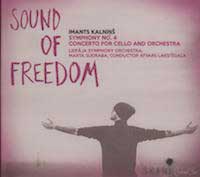Besides being one of Latvia’s most beloved composers of popular music, Imants Kalniņš has also composed many well-known works in the field of Latvian classical music. Kalniņš has shown himself to be a master of melody, and his flowing and expressive style has resonated with listeners for decades. Among his many compositions – choir arrangements and cantatas, symphonic works, among others – perhaps his best known work is his Symphony No. 4, composed in 1973. The work combines classical elements with modern, rock elements to create a dramatic and compelling symphonic fusion.
Recognizing the significance and importance of this work in the history of Latvian symphonic music, the Latvian Music Information Centre released the album Sound of Freedom (Brīvības skaņa) in 2015, featuring Kalniņš’ Symphony No. 4 (and his earlier Concerto for Cello and Orchestra, from 1963) on their Skani record label as part of the Centennial Series (celebrating the best works in Latvian classical music in preparation for Latvia’s centennial in 2018), as performed by the Liepāja Symphony Orchestra, conducted by Atvars Lakstīgala.
As the work is one of the most popular Latvian symphonic works, there are already at least three released versions, so one may ask if there was a need to release yet another version of the work. In this release, there is actually a very significant artistic choice made by the performers that distinguishes this recording and it makes Sound of Freedom a particularly interesting and worthwhile release.
Kalniņš’ Symphony No. 4’s first movement already displays elements that distinguish the work – particularly the bass guitar (performed by Aivars Meijers) and drums (performed by Vilnis Krieviņš), elements that led to this symphony being given the Rock nickname. The quiet and deliberate performance, full of tension and agitation, gradually builds to a crescendo involving the entire orchestra, as the relentless build reaches its pinnacle. However, after this climax, the tension recedes as the music fades away.
The calm at the end of the first movement then flows into the second movement, a more tranquil work, even playful. The almost childlike introduction transforms into a heavier, weightier theme, featuring the horns of the orchestra, giving it an almost military feel, which then transforms into a dreamy dance to close out the movement.
The third movement is at once celebratory and ominous, with its slowly ascending melody. Beginning with a mournful melody on the horns, the melody then transforms into a triumphant and exulting theme.
The major change in this performance is in the fourth movement, which normally includes a vocalist singing the words of American poet Kelly Cherry. However, when the work was first performed, the Soviet censors objected to the English text, and the part of the vocalist was instead performed by the horns and the strings. On Sound of Freedom, the record features the censored, instrumental version. To some that are more familiar with the vocal performance, this version may be jarring, however, without the vocals, the orchestra is more in the forefront. Additionally, Cherry’s poetry could be, at times, a bit maudlin for some listener’s tastes – pithy lyrics like ‘when you left, I cried’. At the very least, the orchestral version allows for a much different experience, and leaves the meaning of the music more up to the listener to decide.
The cello concerto, Kalniņš first symphonic opus, is a single movement work composed in the 1960s, and is more in line with the artistic demands of the Soviet authorities. One can almost feel Kalniņš constrained by the oppressive Soviet regime, as well as being a young composer searching for his voice (the work was composed while Kalniņš was still a student). The work, at times drab and even colorless, is perhaps more a historical curiosity than a work of art, and the nature of the work is a bit jarring with the Symphony. Still, it shows how Kalniņš grew and evolved dramatically as a composer in a decade’s time. Distinguished Latvian cellist Marta Sudraba brings the right touch of melancholy and emotion to the solo sections, elevating this work that otherwise might have remained overly academic and formal.
The title of the album – Sound of Freedom – might seem strange to some, especially considering that during the time the works were composed – the 1960s and 1970s, deep in the Soviet occupation of Latvia – freedom was one of the last things on the minds of Latvians – a practically unrealistic dream. Though, perhaps, that is the point – the Latvians never gave up hope, even during these dark times, and Kalniņš music gave them hope – that they could express their desires and yearning through music. The nature and tone of the work was a contrast to the standard Soviet symphonic composition, and deeply affected many Latvian listeners.
The CD also includes extensive notes on Kalniņš and his works, as well as brief biographies of the Liepāja Symphony Orchestra and Atvars Lakstīgala, by composer Imants Zemzaris in both Latvian and English
Sound of Freedom is yet another excellent and noteworthy release by the Skani label, another testament of the unique and individual nature of Latvian music, as well as the skill and talent of the Liepāja Symphony Orchestra and conductor Atvars Lakstīgala. As Latvia approaches its centennial, this CD is an apt reminder of both the fears and hopes of Latvians in the darkest times in their history.
For further information, please visit the Skani website.
Sound of Freedom
Liepāja Symphony Orchestra
LMIC, SKANI 042, 2016
Track listing:
- Imants Kalniņš – Symphony No. 4 – I. Allegretto
- 4th Andante tranquillo
- Grave
- Moderato rubato
- Concerto for Cello and Orchestra
© 1995-2025 Latvians Online
Please contact us for editorial queries, or for permission to republish material. Disclaimer: The content of Web sites to which Latvians Online provides links does not necessarily reflect the opinion of Latvians Online, its staff or its sponsors.





